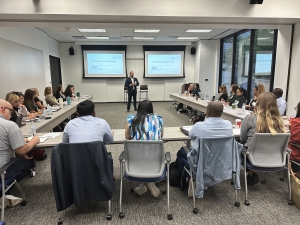PESA has performed a diversity study across the oil and gas industry’s service, supply, and manufacturing organizations to analyze the current state, in-flow, and out-flow of female talent and identified actions organizations can take to advance women into greater leadership positions.
The oil and gas industry has historically struggled with attraction and retention of female talent. In the United States (U.S.), women comprise 47% of the workforce (15% within the oil and gas sector overall).
Today, in the United States, women comprise 16% of the service, manufacturing, and supply sector of the oil and gas industry workforce.
Currently, only 8% of U.S.-based technical operational roles (e.g., manufacturing, field engineer) within the sector are filled by women, and over 80% of respondents have less than 8% of top leaders in technical operational roles as women. Alternatively, the percentage of women in U.S.-based business support roles (e.g., HR, Legal) is significantly higher at 31% and over 80% of respondents have less than 21% of women in top leadership positions in support functions.
When looking at 2017 in-flow of female talents into the sector, of total US entry-level sector hires, 15% are women as compared to 18% of women experienced hires. This trend varies slightly when differentiating hires between companies with less than 1,000 employees, where U.S. entry-level hires represented 15% and experienced hires represented 12% of 2017 in-flows of female talents.
Increases in in-flow are an important step towards companies achieving equality, however there has historically been a discrepancy between the numbers of women entering the sector industry versus their overall percentage in the workforce over time. While most respondents (51%) do not actively track why women are voluntarily exiting, those that do cite the most common reasons for exits as:
- Limited career opportunities,
- lack of flexible work programs, and
- lack of effective sponsorship and mentoring
Several sector companies have implemented strategies designed with gender equality and advancement of women into leadership positions as the objective. However, there remains an opportunity to scale such programs across the sector.
- 20% have C-level endorsed gender diversity strategies
- 34% offer 6 or more weeks of paid primary caregiver parental leave
- 31% offer learning and development initiatives targeted at inclusion and diversity
- 60% offer basic flexible work programs, such as telecommuting
- 15% offer mentorship programs and actively track female participation
Retention and advancement programming with C-suite endorsement and visibility have the potential to make substantial impacts to individual women’s experiences as well as on overall gender diversity in the industry. By working to further understand unmanaged attrition and implementing solutions in response, the service, supply, and manufacturing sector of the oil and gas industry can reduce the outflow of women and become an increasingly diverse place to work.
Click here to read the entire PESA Diversity Benchmarking Study.
METHODOLOGY
PESA surveyed more than 35 companies, covering over 250,000 working men and women globally – including 100,000 working men and women in the United States. Companies with less than 1,000 global employees were specifically included, in addition to the largest sector participants, to gain insight into practices prevalent throughout the sector within the many smaller organizations which represent the fabric of the industry. PESA also analyzed published data related to a range of workforce issues, including labor force, progression, talent gaps, culture at work, company gender by level, and company best practices.




